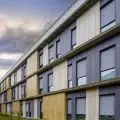There is a public road between the plots to ensure communication accessibility. Access and accesses are designed for the movement of coaches, municipal and fire vehicles and easy pedestrian access. In the southwestern part of the site, storage areas for watercraft and parking for coaches and cars, including those with disabilities, are provided. A public building with technical infrastructure and recreational space, including an entrance plaza, pedestrian paths, benches, sculptures and art installations, has been designed in the opposite part. A pier was provided along the waterfront to provide access to the water. Greenery, trees and a rain garden were laid out, as well as a paved plaza with containers for waste separation. Urban and architectural barriers were minimized to make the space safe and welcoming, and development elements ensured the building's integration with its surroundings.

landscaping project, silhouette of the development - south
© Aleksandra Senderska
spatial layout and architectural form
The educational and exhibition center on the Salt Island in Kolobrzeg is a single-story, oblong block along the bank of the Parsęta River. The building's fluid and dynamic form is reminiscent of meanders and sea waves. The earth embankment, which is an integral part of the building, increases the aesthetic value, insulates the interior from noise and protects the banks from erosion. The curves of the exterior walls create sheltered courtyards and squares, blending harmoniously with the interior of the building and providing light to the rooms. An organic roof, planted with native vegetation, continues the green areas around the building. Traffic spaces and the geometry of the facade allow for the organization of covered, glazed entrance spaces, providing free access from the front of the building to the boulevards.

cross sections
© Aleksandra Senderska
The building consists of four key functional zones: entrance and administration, exhibition, education and catering. The exhibition space is divided into three sections: thecoastal zone(littoral), the open water(pelagial) and the deepest parts of the ocean(bental and hadal). Each section has its own unique environmental features, which will be showcased through aquariums, interactive displays, interior design, color schemes and audiovisual effects such as simulated ocean currents. The project aims to raise awareness of marine conservation through cooperation with local institutions and environmental organizations, and to allow the public to participate in scientific endeavors. The building is ergonomic, a natural starting point for hiking in the area and an integral part of the public space, used for recreation and the organization of exhibitions and workshops.

features
© Aleksandra Senderska

visualization of the entrance
© Aleksandra Senderska
construction-material and technical-installation solutions
Due to the proximity to the river, it is necessary to adapt the foundation of the building to the complex water and soil conditions, embedding concrete piles if necessary. Intermediate foundations have been designed - a monolithic reinforced concrete slab that will distribute the building loads to the ground. The slab will be connected to a ground source heat pump, which is an efficient and environmentally friendly solution. The horizontal and perimeter thermal insulation of the foundation made of XPS polystyrene will provide mechanical strength and frost resistance. The load-bearing walls made of reinforced concrete will be protected by a profiled membrane. A green soffit with vegetative and filter layers and an air recuperation system will reduce energy consumption. A facade of architectural concrete, juxtaposed with glass panels and steel elements, will give the building a modern character. The interior will be arranged to suit the purpose of the building, ensuring its multifunctionality. Accessways and driveways will be constructed on a substructure of crushed aggregate and cement-sand ballast, and finished with large-format paving and road plates. In addition, the site will include a rain garden, whose main task is to collect rainwater from nearby areas, including paved surfaces such as parking lots and sidewalks.

3D cross-section
© Aleksandra Senderska
The center has the potential to become a meeting place and an exchange of ideas for the local community, entrepreneurs and people interested in the subject of seas and oceans, which may contribute to increasing the attractiveness of the Kolobrzeg Seaport for both residents and tourists.


















































